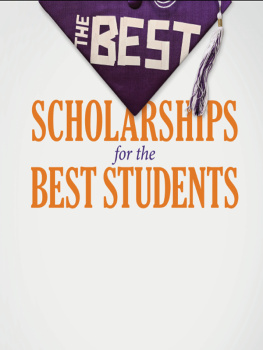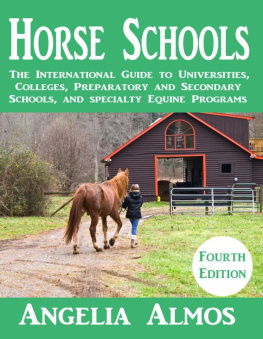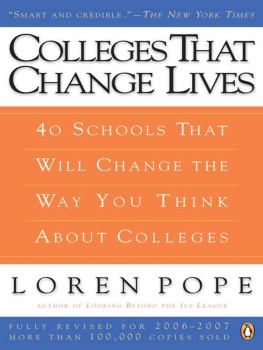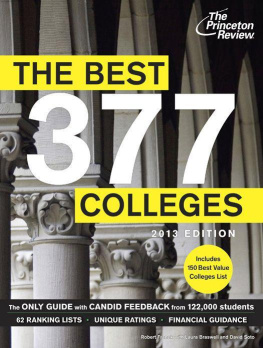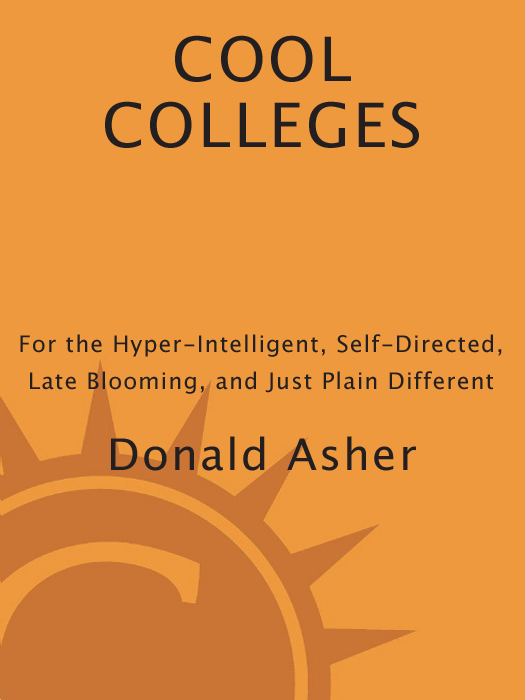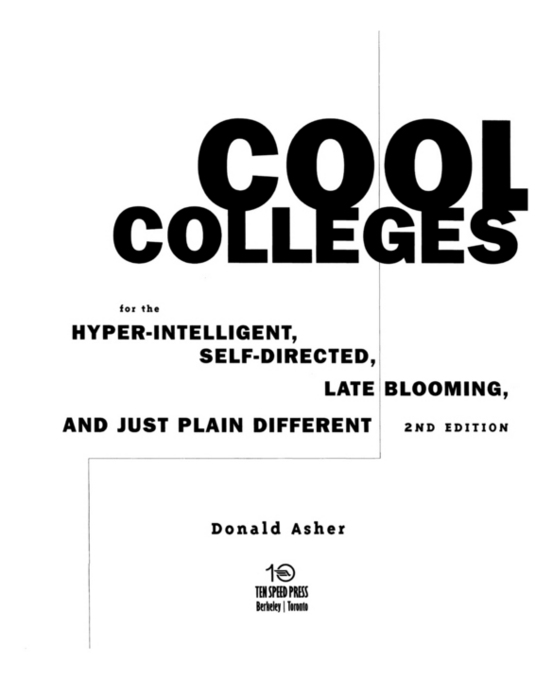Copyright 2007 by Donald Asher
All rights reserved. No part of this book may be reproduced in any form, except brief excerpts for the purpose of review, without written permission of the publisher.

Ten Speed Press
Box 7123
Berkeley, California 94707
www.tenspeed.com
Distributed in Australia by Simon & Schuster Australia, in Canada by Ten Speed Press Canada, in New Zealand by Southern Publishers Group, in South Africa by Real Books, and in the United Kingdom and Europe by Publishers Group UK.
Production by Jeff Brandenburg
Thank you to the following for granting permission to use their work:
Secret to Finding ScholarshipsThere Isnt One by Jane Bryant Quinn () copyright 1999, the Washington Post Writers Group. Reprinted with permission.
Excerpt from Looking Beyond the Ivy League, revised edition, by Loren Pope () copyright 1990, 1995 by Loren Pope. Reprinted by permission of Penguin Books and the author.
Western Colleges Finally Get Their Due () copyright 1999 by Janet L. Holmgren. Reprinted with permission.
Excerpt from Colleges That Change Lives by Loren Pope () copyright 1996 by Loren Pope. Reprinted by permission of Penguin Books and the author.
On College Counseling for the Intellectual Student () copyright by Laura J. Clark. Reprinted with permission.
Narrative evaluation () used by permission of New College of the University of South Florida.
What is Intelligence? () copyright by Ruby Ausbrooks. Reprinted with permission.
Why Kids Arent Happy in Traditional School () copyright by Ruby Ausbrooks. Reprinted with permission.
The Big Meeting () copyright by Crystal Finkbeiner. Reprinted with permission.
The Filene Center for Work & Learning () copyright by Dan Golden. Reprinted with permission.
A Life of Work and Learning () copyright by Dennis Jacobs. Reprinted with permission.
Why I Finally Chose to Attend an Historically Black College () copyright by Amelia R. Shelby. Reprinted with permission.
Library of Congress Control Number: 2007922323
eISBN: 978-0-307-79770-4
v3.1
For
Lisa Bertschi
CONTENTS
Is the SAT Really Fair?
Average SAT Scores as a Factor of Family Income
Average SAT Scores as a Factor of Race
Cool Book Alert! This Way Out: A Guide to Alternatives to Traditional
College Education in the United States, Europe, and the Third World by John Coyne and Tom Hebert
ACKNOWLEDGMENTS
Nobody writes a book like this by himself or herself. Many, many people helped out in ways great and small. First and foremost I must thank my research assistant, Denise Rhiner, of Pyramid Communications in Seattle, who worked tirelessly to track down thousands of pesky details. There are still plenty of errors in this book, but they are all mine. Denise never makes a mistake. Thanks to my publishing team at Ten Speed, Phil, Lorena, Fuzz, and Hal. Also, very special thanks to Jeff for all his work on the interior of the new edition, and Catherine for an awesome new cover. Also, a few thousand people in higher education helped me to research and compile this book, including college presidents, deans and directors of admission, and public affairs officers. My surveys elicited warm and thoughtful comments from the best and the brightest at institutions all over North America, and I am grateful for their contribution. Special thanks to Kate Goldberg, college planning counselor, French-American International School in San Francisco; Laura J. Clark, college planning counselor, Ethical Culture Fieldston School in the Bronx, New York; Larry Large, president, Oglethorpe University in Atlanta; Janet Lavin Rapelye, dean of admission, Wellesley College; Janet L. Holmgren, president, Mills College; Fred Hargadon, dean of admissions, Princeton University; Marlyn McGrath Lewis, director of undergraduate admissions, Harvard University; and Dr. Dan Golden, director, the Filene Center for Work & Learning, Wheaton College in Norton, Massachusetts. Special thanks to L. M. Boyd, the trivia meister, author of The Grab Bag syndicated column, and the original source for a number of the academic trivia items in this volume. Very special thanks to Mr. Steve Old Elk, who rescued me when I needed it most. My greatest appreciation goes out to Dr. Judy Jones, one of my earliest mentors, who set this train in motion. Likewise to my mother, Dr. Ruby Ausbrooks, who was in school, like, forever, and my older brother, Bill, and younger brother, Clyde, who proved to me that anything is possible. I also need to acknowledge Professor Walter Englert, classics, Reed College, who is a credit to the profession of professing; and Tom Francis, director of career services, Swarthmore College, a true friend and a fine wrecker of boats.
Introduction
WHERE THIS
BOOK
CAME FROM
I didnt really fit in at high school. The classes moved along at a glacial pace, until I felt that Id just pull my hair out one strand at a time out of sheer boredom.
The dean of students had a personal vendetta against me. Id be in a crowd of students and hed see Don Asher and some nice young people. It was probably some kind of pattern recognition thing. Like that time I wore a Native American getup to Western Day, and got sent to the principals office for my lack of spirit, whatever that was. I never did really understand school spirit. I always thought school was about learning, and this spirit stuff was usually some blatant glorification of the very students who werent learning anything. It seemed like a perverted recognition system to me. I didnt fit expectations. Sometime in high school I began to realize that systems in general were not designed for me.
I was not alone. My friends and I were always doing the challenge problems in the math books (and sometimes wed even remember to turn them in). We talked in puns, collected oxymorons, read ahead in the books, wrote poetry, and drew cartoons in class. We gloried in discovering the historical inaccuracies of our texts, and had long arguments about minutiae, often bringing in outside references our teachers knew nothing about. We didnt always get the top grades. We were difficult. We were trying so very hard to stay interested in an educational system that clearly was not designed for us.
Then I discovered a program whereby I could go straight into the largest university in the state without graduating from high school! All I needed were three things: the right grades (had em), the right SATs (had em), and a letter of recommendation from my high school principal. The only thing standing between me and this blessed event was a recommendation from my high school principal. He was a thin, bald man, who left all troubles to the dean of students. I knew the dean well, but Id never actually spoken to the principal. Would he write me a letter? Would he release me? Id be glad to, he said, with a smile I couldnt interpret.
And so I went to college. Heaven at last, I thought. A university! Where theyll treat me like an adult! Where learning is the raison dtre for the entire institution!
The first week of classes the dean of students secretary called me and said, The dean wants to see you in his office. Would you be available on Wednesday at two? What had I done now? I wondered. I thought all deans were alike, and I thought maybe my high school dean had called this university dean and warned him about me.


